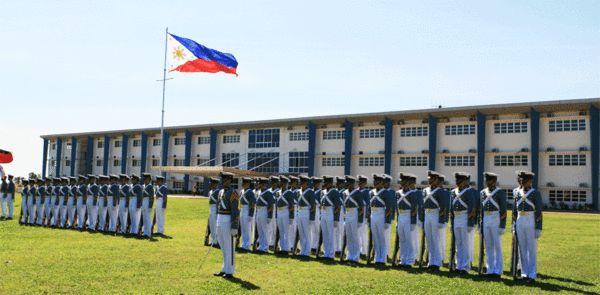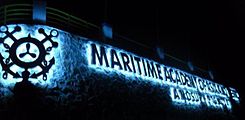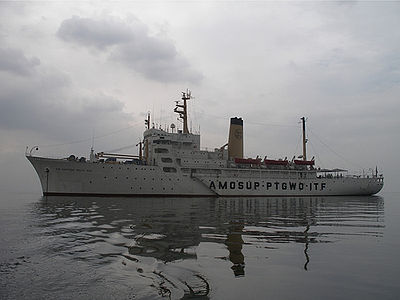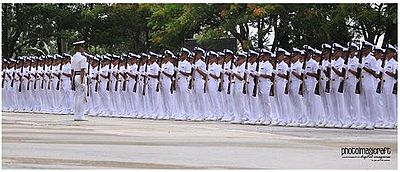- Maritime Academy of Asia and the Pacific
-
"MAAP" redirects here. For the municipality in Micronesia, see Maap.
Maritime Academy of Asia and the Pacific (MAAP) "Ensuring excellence at sea at all times."
MAAP-Kamaya Point
(Tagged Name)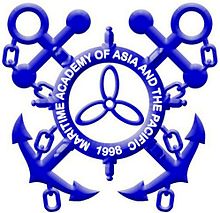
Motto Virtus, Fides et Disiplina Established January 14, 1998
Cradle of Destiny
(Academy Hymn)Type Private Institution President ADM Eduardo Ma. R. Santos, AFP (Ret.) Location Kamaya Point, Alas-asin, Mariveles, Bataan, Philippines 2105 Campus 103 hectares
*MAAP-East
(Old Campus)
*MAAP-West
(New AJSU-IMMAJ Campus)Affiliations AMOSUP, PTGWO, ITF, FAME, JSU, IMMAJ, NSU, IMEC, NSA, JSA, Philippine Navy Website www.maap.edu.ph The Maritime Academy of Asia and the Pacific (MAAP) is a non-stock, non-profit maritime higher educational institution which is owned, developed and operated by the Associated Marine Officers’ and Seamen’s Union of the Philippines (AMOSUP). AMOSUP President Capt. Gregorio S. Oca heads the Academy’s board of governors, a group comprised by some of the most influential organizations in the international maritime industry: the Filipino Association of Maritime Employers (FAME), the International Transport Workers’ Federation (ITF), the All Japan Seamen’s Union, the Norwegian Seafarers’ Union (NSU), the International Maritime Employers Committee Limited (IMEC), the Danish Shipowners Association, the Norwegian Shipowners Association (NSA), Japanese Shipowners Association (JSA) and the International Mariners Management Association of Japan (IMMAJ). With their technical and financial support, the first MAAP campus opened its doors to its first batch of students in 1999.
Recognizing the Filipino as one of the most valuable human resources, the All-Japan Seamen’s Union (JSU) and the International Mariners Management Association of Japan (IMMAJ) has partnered with MAAP to build a second facility within the Academy grounds, the JSU-IMAAJ Campus.
MAAP’s primary objective is to meet the ever increasing demand of both local and foreign shipping companies with well disciplined, ably trained, competent and qualified deck officers and marine engineers who are readily at hand in a globally competitive maritime trade and industry.
Contents
History
Committed to be one of the world's best, MAAP was established on January 14, 1998 at Kamaya Point, Alas-asin, Mariveles, Bataan, in an 18-hectare land equipped with the state of the art facilities and an academy that is at par with other world maritime schools in terms of academic excellence in maritime education and training. It was inaugurated by Philippine President Joseph Ejercito Estrada on 6 November 1999. It was founded by Capt. Gregorio S. Oca, chairman of the Associated Marine Officers and Seamen's Union of the Philippines (AMOSUP).
It is run by a governing board from the AMOSUP, the private sectors, the Danish Shipowners Association, the Norwegian Shipowners Association, the Japanese Shipowners Association, the All Japan Seamens' Union, the International Worker's Transport Federation, the International Maritime Employees Committee, and the Filipino Association of Mariner's Employment.
In 2009, the academy expanded into 103-hectare from its initial 18-hectare land area. Two Japanese seafarer organizations, the All Japan Seamen's Union (JSU) and the International Mariners Management Association of Japan (IMMAJ), contributed to the construction of the new campus and was involved from then on with its operation. Hence, the additions to its initials "AJSU-IMMAJ Campus".
 President Gloria Arroyo listens to MAAP president in her visit to the academy.
President Gloria Arroyo listens to MAAP president in her visit to the academy.
Ahead of its inauguration in June 2009, the academy held a grand ceremony on April 7. Philippine President Gloria Macapagal-Arroyo attended the event, as had other interested parties from Japan and the Philippines.
Facilities
The two campuses are located on a hill near Manila Bay and Corregidor Island. Each has three main buildings: an academic building with classrooms, simulators, laboratories and a library; a dormitory with a capacity of 1,000; and a dining hall. Two Scandainavian-made simulators are housed in the academic buildings.
Summary of Facilities:
- Navigation Simulator Complex with 360° field of vision on a platform each linked to Full Mission Engine Simulator
- Chart/ECDIS Exercise Room
- GMDSS Laboratory
- Liquid Cargo Handling Simulator
- Computer-based Propulsion Plant
- Electrotech Laboratory
- Machine Shop
- Physics Laboratory
- Chemistry Laboratory
- Microwave VSAT System and 3 servers for Telecommunications & Internet Access
- Computer Laboratory
- Refrigeration/Air-conditioning Laboratory
- Japanese Compact Ship Handling Simulator
- Pneumatic/Hydraulic Laboratory
- Electromechanical Systems & Automation Laboratory
- Liquid Natural Gas Simulator
- Fire Fighting Center
- Vessel Training Center
- Enclosed Lifeboat on Free Fall Davit
- Chemical/Product Tanker Simulator
- Language Laboratory
- Modern Library with over 8,000 titles
- Helicopter Underwater Escape Trainer
- Demonstration Kitchen for culinary courses
Academic degrees
The academy awards the following degrees:
-
- Bachelor of Science in Marine Transportaion (BSMT)
- Bachelor of Science in Marine Engineering (BSMarE)
- Bachelor of Science in Marine Transportaion and Engineering (BSMTE)
The academy also offers subsidiary and supplementary courses such as Cook's Course, Bridging Program, Trainings on Fire Fighting and Medical First-Aid.
Its ROTC program is supervised by officers from the Philippine Navy.
Its first Graduates for the dual course(BSMTE) came from the Class of Valchirion (2009). Graduates of the said course are sponsored by Maersk Filipinas.
Training Ship
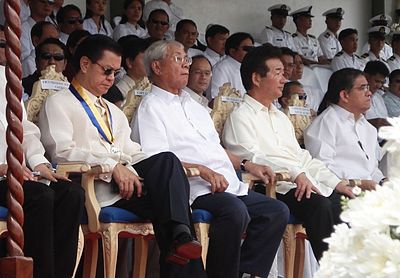 Groundbreaking ceremony for the new campus. In attendance were Vice President Noli de Castro, academy founder Capt. Gregorio Oca, AJSU presiddent Yoji Fujisawa and DOLE secretary Marianito Roque.
Groundbreaking ceremony for the new campus. In attendance were Vice President Noli de Castro, academy founder Capt. Gregorio Oca, AJSU presiddent Yoji Fujisawa and DOLE secretary Marianito Roque.
The T/S Kapitan Felix Oca was launched by NKK Corp. as M/S SEIUN MARU on July 1968 at Yokohama, Japan. First owned by Inter Pacific Lines Co.,Ltd. of Japan and utilized as a training ship.
In 1997, AMOSUP (Associated Marine Officers and Seamens Union of the Philippines) acquired the training ship M.V. Seiun Maru from the Ministry of Transport of Japan. Delivered in Manila on Nov. 19, 1997 and placed under Philippine Flag with vessel name “ T/S KAPITAN FELIX OCA “.
Designated as a Philippine Navy Affiliated Reserve Unit (PNARU) on 24 September 1999.
The TSKFO is equipped with a training bridge with actual navigation instruments, engine lecture room, engine exercise room and automated engine control room.
BASIC INFORMATION
Owner Associated Marine Officers and Seamen’s Union of the Philippines (AMOSUP) Ship Manager Maritime Academy of Asia and the Pacific-Kamaya Point (MAAP-Kamaya Point) No. of Crew 28 Total Capacity 247 No. of Cadets 180 Ship’s Earth Station ID No. 1701575 Port of Registry Manila Registration No. 105069 IMO No. MNLD009840 Call Sign DYHH VESSEL PARTICULARS
ENGINE PARTICULARS
Length 114.55 m Engine Hitachi2BF-110 750 VT-B&W Diesel Breadth 26 m Boiler Water Tube 1 unit single drum Depth 8 m Service Speed 16.72 knots Net Tonnage 1508 tons Gross Tonnage 5028 tons Deadweight 5781.20 tons References
External links
Categories:- Educational institutions established in 1998
- Maritime colleges
- Universities and colleges in the Philippines
Wikimedia Foundation. 2010.

